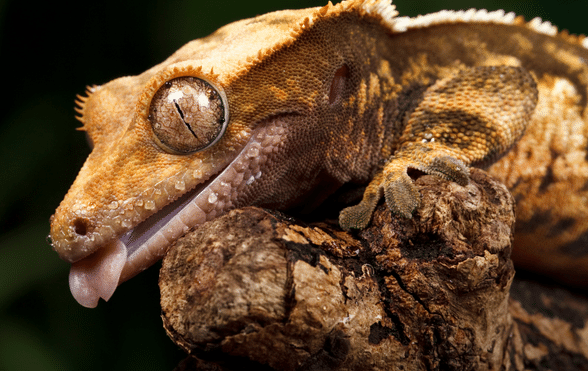Every lizard requires specialist care, regardless and most people looking for a ‘beginner’ lizard are doing so because children will be involved with its care. Therefore my beginners list incorporates this as a ranking order, to determine easiest from hardest
Don’t forget your lizard insurance! Get a quote for £1,000 of vet fees, death and theft cover. Vet fee cover only also available | We’ve been insuring exotic pets since 1996 | Check out our customer reviews on Feefo.
There are so many factors that go into caring for any species of animal. The ‘best’, I feel, would always be personal preference.
But regardless of what your personal choice is, the factors regarding the setup and lizard size, food costs and so on, all factor into any decision when choosing your pet.
Popular and increasingly popular species include:
- Bearded Dragon (Pogona vitticeps)
- Leopard gecko (Eublepharis macularius)
- Veiled chameleon (Chamaeleo calyptratus)
- Monitor lizards
- Uromastyx
- Tokay gecko (Gekko gecko)
- Blue tongued skink (Tiliqua scincoides intermedia)
- Frilled dragon (Chlamydosaurus kingie)
- Chinese water dragon (Physignathus cocincinus)
- Crested gecko (Correlophus ciliates)
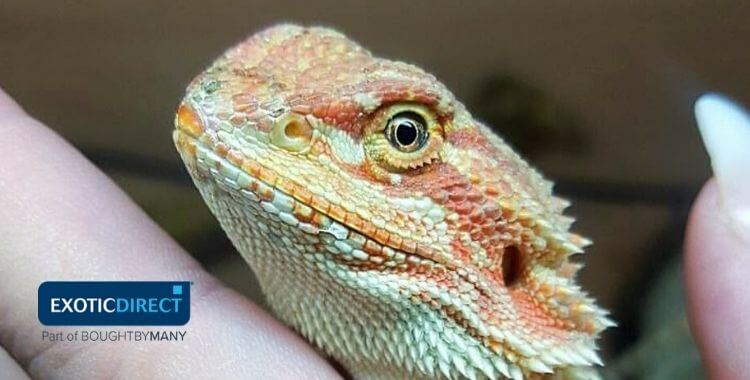
The Bearded Dragon is one of the most popular pet lizards
Best pet lizard for beginners
Every lizard requires specialist care, regardless. And the above listed are no exception.
If children are involved in lizard care, you should always supervise any interaction.
Any UVB mentioned in this article is a linear Tube UVB, not coil or all-in-one bulbs. These are simply not good enough.
Arcadia ProT5 offer the best UVB options available and strength can be species and setup height dependent.
Bearded Dragon
Child friendliness: Due to its ease of handling, and being active during daylight hours, this is my top choice as ‘easiest’ and importantly, child friendly reptile.
Probably the worlds most popular pet lizard. The Central Bearded Dragon is found throughout most of Southern Australia. Also, regions of Queensland, Victoria, and New South Wales.
It’s popularity as a pet is due to its placid nature. More so once past that baby and juvenile stage (0-12 months).
Although they are still placid under one year of age, they are far more jumpy and easily startled. And with them being very fast when small, it can be a problem when it comes to any handling.
But once over a year old and fully grown (at around 15 months) they slow down more, are far less jumpy, and at this stage certainly tolerate short handling sessions with a more relaxed demeanor.
Diet: Diet wise Bearded Dragon’s have a diet of both insect and plant matter throughout their lifetime.
Lighting and heating: They also require specialist lighting provided by a white heat bulb with a basking zone of around 38-40c.
UVB: They need a high UVB exposure via a reflected UVB tube at the correct distances for their needed exposure (not coil UVB or all-In-one).
Vivarium and size: Their wooden vivarium should be a minimum size of 4ft x 2ft x 2ft and this should be their forever home. The average size of an adult Bearded Dragon reaches around 20 inches, so go even bigger still if you can. But certainly not smaller.
You can learn more about the best setup for a Bearded Dragon here.
Lifespan: Bearded Dragons can live an average of 8-10 years in captivity, with many going far beyond that with our current husbandry knowledge and technological advancements.
In summary, given the correct lighting, vivarium size, enrichment and environmental conditions, Bearded Dragons are quite an active reptile.
Your dragon will be visible while eating, basking, and going about its business throughout the day. And it makes a great pet for children.
Don’t forget your lizard insurance! Get a quote for £1,000 of vet fees, death and theft cover. Vet fee cover only also available | We’ve been insuring exotic pets since 1996 | Check out our customer reviews on Feefo.
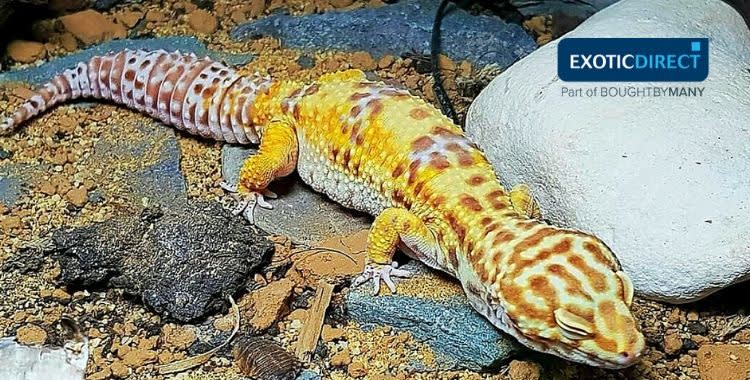
Leopard gecko
Found in the highlands of Asia and throughout Afghanistan, right through to parts of northern India.
Size and lifespan: With an average size of around 10-12 inches and living a good 15-20 years, this small gecko species is a shy and placid one.
Most active: Being a crepuscular species (more active during dawn and dusk times) it may not be the ideal choice for children due to the limited time it will make itself visible. Certainly for younger children.
Handling: Like the Bearded Dragon, they do ‘tolerate’ short handling sessions, although they do tend to keep moving once out of the enclosure making it more difficult for smaller children.
Vivarium, heating and UVB: Needing at least a 3ft x 1.5ft x 1.5ft enclosure, bigger if possible but not smaller, they require overhead heating, as heat always comes from above in nature.
They also require a low-level UVB during the day. The Arcadia ShadeDweller is perfect for this task and designed for such species.
Diet: They are an insect only eating species and tend to want such after the lights are out in the setup.
Learn more about Leopard Gecko vivarium setups here and what Leopard gecko’s eat.
Blue-tongue skink
Naturally found roaming the woods and grasslands of Australia, this lovely lizard has become ever popular over the past 10 years.
It has very much the same requirements as the Bearded Dragon.
Size and lifespan: The Blue-tongue skink will grow to around 20-22 inches on average, and will live a good 15+ years with an optimal captive setup.
UVB and heating: The same UVB and heat requirements as the Bearded Dragon are needed.
Diet: They will also need the same diet as the Bearded Dragon, which is a varied insect and veg/plant one.
There is nothing a Blue-tongue skink loves more than basking during the day after eating, stretching out over a piece of flat slate to absorb some of that naturally stored heat from under the basking bulb.
So with the above being said, they will be visible throughout the day, although they are not the most active of lizard. They are placid and will tolerate handling without issue.
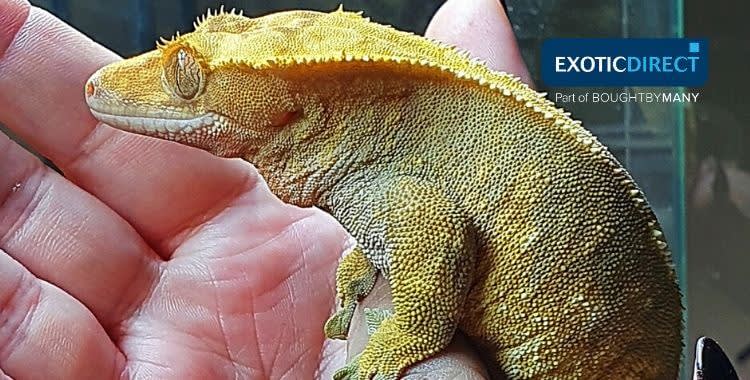
The Crested Gecko is a relatively easy species to care for
Crested Gecko
Native to the forests of New Caledonia, this lizard is recognisable by its protruding eye socket resembling the look of eye lashes.
Size and lifespan: This small crepuscular arboreal (tree dwelling) lizard grows to around 10 inches and lives a good 15 plus years under the right care.
UVB and vivarium: Like the Leopard Gecko, being active more at dawn and dusk hours, these do require UVB. Again, low-level UVB such as the Arcadia Shade Dweller is perfect for the job in a glass terrarium that is at least 45cm x 45cm x 60cm.
Diet: Their diet will consist of mainly insects, with the likes of a Pangea or Repashy premix powder being offered once or twice a week.
Setup: Being tree dwellers, they do require plenty of coverage and branches, vines and leaves to hide within and climb on.
Humidity: They also require a good humidity range of around 60-80% via a daily spray down or two of the enclosure.
On the whole, a relatively easy species to care for, it’s worth noting here that being quite a shy species, they don’t always handle well. Some don’t like it at all. So do bear in mind yours may well be a visual only gecko.
Uromastyx
There are a number of Uro species across Africa and Asia. But the most common available in the hobby are the Moroccan and Mali, with the Ornate and Geyri also gaining popularity.
Diet: For whatever Uro species chosen, you’ll have a placid herbivorous species (only eating vegetation).
Size: Depending on the commonly kept species you choose, the maximum size is going to be around 20 inches. With the likes of the popular Moroccan being smaller, at around 10-12 inches.
Vivarium and UVB: Care is pretty much the same as the Bearded Dragon regarding setup size – you should aim for a vivarium size of 4ft x 2ft x 2ft. The UVB requirements are also much the same. Although the basking zone can be a little warmer for the Uromastyx.
Lifespan: With the correct care you’ll have a lizard that will bask and eat throughout the day, and can be in your family for a good 15+ years.
Best lizard for intermediate pet owners
These lizards are harder to care for. I’d only recommended them for more experienced keepers.
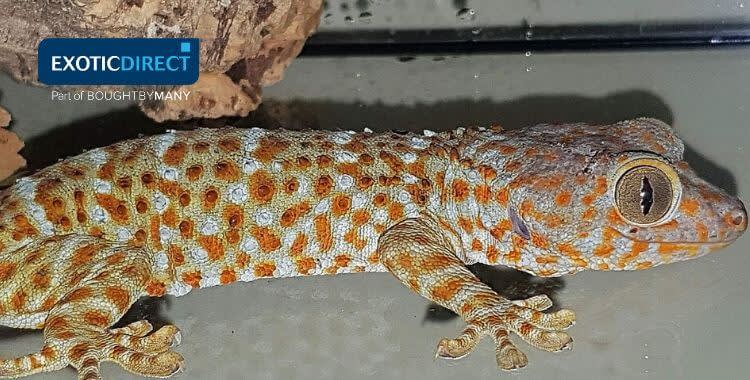
The Tokay Gecko is a display only pet, suitable for intermediate owners
Tokay gecko
This is an aggressive crepuscular arboreal gecko. Native to Asia, as well as some Pacific Islands.
Size and lifespan: The Tokay gecko is of my favourite lizard species, growing on average to around 12 inches in length and living a good 8 to 10 years under optimal setup conditions.
This crepuscular arboreal insect only eating lizard has beautiful colours and an attitude that more often than not, matches its reputation.
This lizard will be a display only lizard. I highly doubt you’ll be handling them much at all, if only for vet appointments, etc. They are renowned for being somewhat shy and aggressive, and in my experience, this is definitely the case.
Terrarium size: Care wise, they’re very similar to the Crested gecko, but I’d aim for a larger terrarium size of around 60cm x 45cm x 60cm.
Humidity: The use of real foliage, plants and cork-bark will aid their humidity needs along with a good spray down of the enclosure daily.
Much like the Leopard gecko and Crestie, they are rarely seen during the day, although you can catch them basking under the provided heat and UVB, However, once spotted they’ll run under cover until the coast is clear to come back out again.
So, although overall care is not hard to achieve, it may be an issue if children are involved due to lack of visual activity. And of course the tendency to be an aggressive lizard.
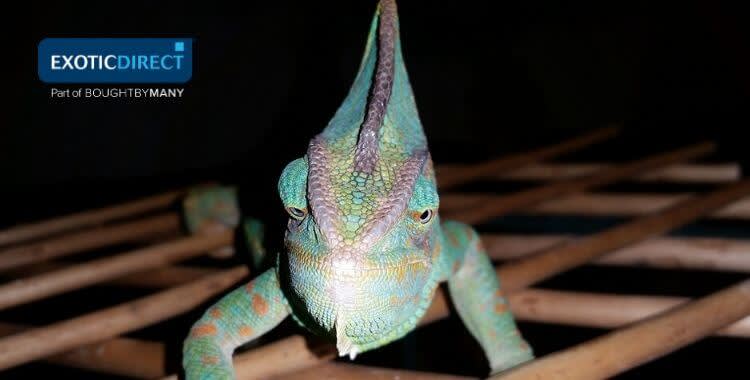
The Veiled chameleon is native to the Arabian Peninsula in Yemen
Chameleon
There are well over 200 species of chameleon. But the most popular and readily available is the Veiled chameleon, with the likes of the Panther chameleon a close second.
Chameleons are a colourful lizard found across Africa, Madagascar, Southern Europe, Asia, and are even found in the likes of Hawaii, Florida, and California, depending on species.
The Veiled chameleon is native to the Arabian Peninsula in Yemen, as well as Saudi Arabia.
Whether it’s the Veiled or Panther chameleon you are looking at, both are renowned to be sensitive to many factors within the care we provide. Thus, making them troublesome for newer keepers.
Diet and vivarium: These insect eating reptiles will need at least a 4ft (high) x 2ft x 2ft arboreal setup, and the correct temperature and UVB for the species.
Lifespan and size: They live for 4 – 8 years and grow to 18 – 22 inches.
Neither the Veiled or Panther chameleon should be a problem when it comes to handling, but I do advise letting your chameleon come to you, not the other way around.
I’ve kept many chameleons over the years, and these have been my observations:
Most chameleons are very setup territorial. They may hiss and strike at you if you are messing around in their setup. But once out the setup on your arm for example, they’ll be the most placid chilled-out lizard ever.
But due to their care requirements, I’d definitely not advise for a beginner keeper.
Learn more about what Chameleons eat and how to setup a Chameleon’s vivarium correctly in our articles also written by Pete Hawkins.
Chinese water dragon
As the name suggests, these are a lizard native to China and mainland Asia, and mainly found near bodies of water, be it rivers or lakes. Hence the name.
This beautiful lizard can grow fairly large around 35 inches on average, and live a good 15 years in captivity, under optimal conditions.
Vivarium size: With that larger size, a large setup is an absolute must. A 5ft x 2ft x 3ft vivarium or bigger will be needed for an adult.
Diet: They are omnivorous, but their diet is mainly insect based, with greens provided as necessary for nutritional variation.
UVB and heat: Again, UVB as with all the species here is absolute must have, as well as a mid 30’s basking zone.
Humidity: Humidity is also vital for this species at around 80%. This may require several spray downs per day, or setting up of an automated misting system. MistKing are the best and you can buy these from Northampton Reptile Centre.
Although I’ve kept this species a number of times, and have had no issue handling if needed, they definitely prefer to be left to their own devices. They’re not great regarding interaction, apart from feeding and cleaning of course. However, you will see them active during the day.
Frilled dragon
This lizard is one native to the Northern parts of Australia, and also around New Guinea. They are called such due to the very large ‘frill’ around their head and shoulders. When threatened it will spread out and looks very impressive.
Lifespan: The Frilled dragon is another fairly large lizard, living a good 12+ years in captivity.
Size and vivarium: It can easily reach 36 inches in length, so a setup size very much similar to the Chinese water dragon is needed. That is a vivarium size of 5ft x 2ft x 3ft vivarium or bigger.
You’ll see them when they’re eating their insect only diet, or when they’re basking under their heat and UVB during the day. But again, this is another species that prefers to be viewed as opposed to handled, so for that reason, it’s on my more ‘Intermediate’ list.
Bosc Monitor
There are around 80 species of monitor lizards. But the most popular within the reptile keeping hobby are the Bosc’s monitor and Ackie monitor, native to Africa and Australia respectively.
Size: Bosc Monitors are an African species and are a large carnivorous lizard that can grow a good 4ft in length.
Enclosure: They will need an enclosure to suit their large size, so it’s easily going to be around 6ft x 3ft x 2ft. However ideally you should opt for 8ft x 3ft x 3ft. Anything smaller would simply be unfair to the reptile.
Heat, UVB and diet: While they would happily lay basking under their provided heat and UVB all day, they will also enjoy the hunt for the food you provide. Bosc’s will eat insects as well as thawed frozen rodents, so it’s best to offer both as part of a varied diet.
Handling: As for handling, these are generally a very placid species. But due to their size and care requirements, I feel not suitable as a beginner species.
Lifespan: They will live for 10 – 15 years.
Green iguana
The Green iguana (Iguana iguana) is a plant eating herbivore reptile, originating from southern Brazil, Paraguay, Caribbean, Florida, Hawaii and the Virgin Islands.
They are an arboreal species, meaning they spend most of their time up in trees.
Lifespan: They will live for 8 – 10 years.
Enclosure: They require a huge setup, a minimum of 6ft x 6ft x 2ft due to the size they can grow, which can average at around 6ft.
They can also be very territorial, meaning they can be aggressive. Therefore I’d never recommend a Green iguana to anyone other than a very experienced keeper. A keeper that can read the behavioural signs of a reptile.
Learn more about what Iguanas eat and Iguana set up advice in Pete Hawkins care articles.
Which is the best lizard for kids?
From the above mentioned, I’d have to say the Bearded Dragon is the best lizard for kids. This is more so when the dragon is over 1 year old, due to its size and agility. Younger Dragons can be harder to handle for small children.
Which is the best large pet lizard?
This is very much dependent on what your own definition of large is. As I’ve had people say my Bearded dragons are large. But once they see a Bosc for example, it’s not even a comparison.
I consider the Bosc from the above listed as the best largest, and certainly a favourite of the species I’ve kept.
Which is the best small pet lizard?
I would have to say both the Crested gecko and Leopard gecko, which are both beautiful and satisfying in their own unique ways.
Which is the best lizard for handling?
The Bearded Dragon wins this again for me.
Which is a low maintenance lizard?
I honestly don’t think any of the mentioned are low maintenance. Due to the specialist diet and setup parameters that need to be met for each species evolutionary needs, all lizards are far from low maintenance.
Which lizards can live together?
Simple answer, none.
I’d not recommend co-cohabitating any species. Most reptiles are very territorial, so would fight or dominate others to gain food, basking areas, hiding spots, etc.
It’s simply not worth the risk and heartache of taking an injured reptile to the vet for treatment that could have so easily have been avoided. Or worse, be put to sleep due to its injuries.
What to expect when you bring your lizard home
First off, you should have everything the lizard needs ready, running and setup prior to bringing it home.
This will not only reduce stress on the reptile, as you are not constantly in and out of the setup, which is now its territory, messing with items. But its less stress on you having to make alterations and worrying you are upsetting the animal.
But regardless, moving a reptile to an unfamiliar environment which is its new setup will be stressful for it, and will require time for them to feel comfortable.
You’ll often find that the first day or two they are home, they’ll be perfectly fine. Basking, eating, no issues.
But then it’s like it dawns on them that they are in a new territory. This is when they hide, avoid eating etc.
In fact it’s not unusual for a new reptile to hide away for a week or so, whether young or old, and this is generally their coping mechanism when in such situations.
What they need to do is establish that setup as their own territory. So it’d recommend keeping any interaction to a very minimum for a good 2 or 3 weeks. Only really interacting for feeding, water changes and cleaning.
Sure, this seems like a long time, but when you consider that you’ll have this reptile in your life for many years, it’s not long in the scheme of things.
This 2 to 3 week period not only gets them used to their new setup, but the sights, smells, and sounds of their new surroundings. And importantly, they get used to you.
The minimal interaction for feeding and cleaning etc gets them used to seeing you around and posing zero threat to them. Thus, having more confidence around you, which in turn gives you more confidence around your new pet.
Where in your home should you put the vivarium/terrarium?
When choosing the location within your home for your setup, there are a couple of vital pointers:
Keep away from windows: The reason being the light and heat caused by the sun coming through the window will really affect the light and heat gradient within the setup.
This can not only cause you issues trying to maintain the temperature within the setup. But also have fatal effects on the setup inhabitant due to the temperature fluctuations.
Keep away from heating elements: Obviously, having a setup next to, or near a radiator or other heating element will also affect the temperature within the setup, thus causing the same effects as the previous issue.
Off ground level: This is one if you have dogs or cats. Having a setup at ground level can cause the animal within much stress if your other house pets are able to view inside the enclosure.
I understand that your dog or cat is extremely friendly and just wants to play. But that dog or cat is friendly to you, not the setup inhabitant. All that lizard sees is a potential predator, and this equals a great deal of stress.
It’s always worth buying the vivarium/terrarium accompanying stand, or finding a sturdy and solid table, desk or case to stand it on.
How long do lizards live?
This, depends on the species. As well as the care put in by the keeper(s).
It’s vital you research all your lizard’s needs regarding the correct heating, UVB and diet.
Don’t be tempted to cut corners on research, or on equipment. Also, register your lizard with a reptile/exotics vet as soon as possible. You can find a vet here.
Where to buy a lizard?
You have a couple of options here:
- Via a reptile shop
- Via a reptile breeder
I’ve used both options myself numerous times over the past 30 odd years, and never really had an issue with either.
When it comes to finding a good store go to a reptile specialist shop, as opposed to large chain store.
You’ll find the staff are far more knowledgeable about the animals and specialised in the environment in which they are working.
More often than not, this is not the case when it comes to the larger chain stores that sell everything from fish, to rabbits.
Same really when it comes to finding a good breeder. Joining social media groups local to yourself and asking for breeders based on positive feedback is the best way.
Don’t forget your lizard insurance. Get a quote for £1,000 of vet fees, death and theft cover. Vet fee cover only also available | We’ve been insuring exotic pets since 1996 | Check out our customer reviews on Feefo.
About Pete Hawkins:
Pete is a reptile enthusiast and has owned many species over the years. He writes for Practical Reptile Keeping, Reptile Apartment and has his own blog: www.reptilenetworks.co.uk
He has also created and is the admin of the Lizard Network, Bearded Dragon network, the Chameleon network, the Reptile and Amphibian network and the Gecko network

